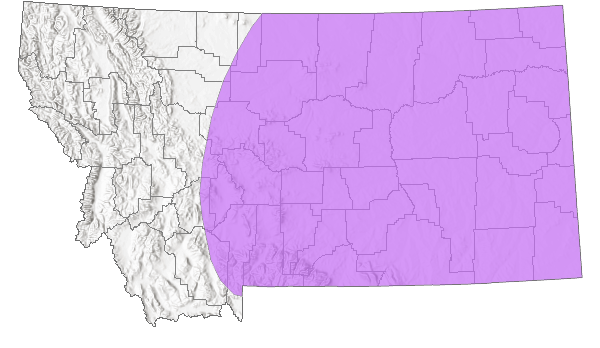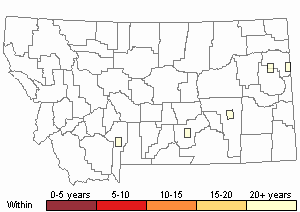View in other NatureServe Network Field Guides
NatureServe
Montana
Utah
Wyoming
Idaho
Wisconsin
British Columbia
South Carolina
Yukon
California
New York
Velvet-striped Grasshopper - Eritettix simplex
General Description
The following is taken from Hebard (1928), Brooks (1958), Helfer (1971), Otte (1981), Capinera and Sechrist (1982), Vickery and Kevan (1985), McDaniel (1987), Pfadt (2002), Capinera et al. (2004), and Scott (2010). This species has two color forms: brown with black and white markings, and green with black, brown, and white markings. The dorsal surface of the head has two black lateral stripes which extend onto the lateral edges of the pronotum bordered by white or cream stripes constricted near the midpoint. The forewings (tegmina) reach the tip of the abdomen. The hind tibia is buff with a dark stripe along the upper edge.
Phenology
Overwinters in the nymph stage and hatches early. In early spring, it is found in its third or fourth instar stage. Adults are present from late May to late July. However, on warm winter spells this species’ nymphs may become active, as they are cold-tolerant, surviving freezing and experimental temperatures as low as 5 degrees F. It is suspected that the Velvet-striped grasshopper may be bivolitine (having two generations or broods per year) (Capinera et al. 2004, Capinera and Sechrist 1982, Otte 1984, Pfadt 2002, and Scott 2010).
Diagnostic Characteristics
The following comes from Hebard (1928), Brooks (1958), Helfer (1971), Otte (1981), Capineraand Sechrist (1982), Vickery and Kevan (1985), McDaniel (1987), Pfadt (2002), Capinera et al. (2004), and Scott (2010).The male body length is 16 mm to 20 mm, and females 21 mm to 29 mm. Antennae are club-shaped at the tip. The forewings (tegmina) are brown or green with a row of dark markings. The outer face of the hind femur is dark dorsally and pale tan ventrally, with no banding.
The Velvet-striped Grasshopper is the only
Eritettex species found in Montana. Could be confused with the
Spotted-wing Grasshopper (
Orphulella pelidna) and the
Pasture Grasshopper (
Orphulella speciosa). Refer to those two species in this Field Guide to compare diagnostic characteristics.
Species Range
Montana Range
Range Descriptions

 Native
Native
Range Comments
This species has two main centers of distribution. The largest area is from the Great Plains states eastward to western Illinois, and from Alberta southward into Mexico. It also has a smaller eastern distribution center along the Appalachian Mountains and their eastern slopes. In Montana, it has been reported in 8 counties (Brooks 1958, Brust et al. 2008, Capinera et al. 2004, Capinera and Sechrist 1982, Hebard 1928, Otte 1984, Pfadt 2002, Scott 2010, and Vickery and Kevan 1985).
Observations in Montana Natural Heritage Program Database
Number of Observations: 5
(Click on the following maps and charts to see full sized version)
Map Help and Descriptions
Relative Density

Recency


 (Observations spanning multiple months or years are excluded from time charts)
(Observations spanning multiple months or years are excluded from time charts)
Habitat
Inhabits areas of mid and tall grass prairies with a diversity of forbs where the understory is
blue gramma (
Bouteloua gracilis), a short grass and preferred food plant. In the Appalachian region, it inhabits open grassy areas in treeless slopes and valleys (Capinera et al. 2004, Capinera and Sechrist 1982, Otte 1984, and Pfadt 2002).
Food Habits
The Velvet-striped Grasshopper feeds almost exclusively on grasses and sedges. When the nymphs emerge in early spring, they feed on the growing cool-season grasses such as bluegrass,
cheatgrass (
Bromus tectorum),
prairie junegrass (
Koeleria macrantha),
thread-leaved sedge (
Carex filifolia), and
needleleaf sedge (
Carex duriuscula). As the season progresses and they enter the adult stage they shift to warm-season plants, especially
blue gramma (
Bouteloua gracilis) (Pfadt 2002).
Reproductive Characteristics
The following is taken from Capinera and Sechrist (1982), Otte (1984), Pfadt (2002), and Vickery and Kevan (1985). The male courtship consists of making three loud stridulations from the grasses, then moves about 12 inches and stridulates again. He follows a female up a grass stem to about an inch from her and rocks from side to side, stops, stridulates, and rushes toward her to copulate. Females oviposit into grass cover, often
blue gramma (
Bouteloua gracilis) or
buffalograss (
Munroa squarrosa, and deposits her eggs through the plant litter into the ground. She lays 12 to 20 eggs per pod arranged in two columns. Nymphs pass through 5 instars before reaching the adult stage.
References
- Literature Cited AboveLegend:
 View Online Publication
View Online Publication Brooks, A.R. 1958. Acridoidea of Southern Alberta, Saskatchewan, and Manitoba (Orthoptera). The Canadian Entomologist (Supplement 9) 90:5-92.
Brooks, A.R. 1958. Acridoidea of Southern Alberta, Saskatchewan, and Manitoba (Orthoptera). The Canadian Entomologist (Supplement 9) 90:5-92. Brust, M.L, W.W. Hoback, and R.J. Wright. 2008. The Grasshoppers of Nebraska. Lincoln, NB: University of Nebraska Extension Service, APHIS.
Brust, M.L, W.W. Hoback, and R.J. Wright. 2008. The Grasshoppers of Nebraska. Lincoln, NB: University of Nebraska Extension Service, APHIS. Capinera, J.L. and T.S. Sechrist. 1982. Grasshoppers of Colorado: Identification, Biology, and Management. Fort Collins, CO: Colorado State University Experiment Station, Bulletin 584S. 161 p.
Capinera, J.L. and T.S. Sechrist. 1982. Grasshoppers of Colorado: Identification, Biology, and Management. Fort Collins, CO: Colorado State University Experiment Station, Bulletin 584S. 161 p. Capinera, J.L., R.D. Scott, and T.J. Walker. 2004. Field Guide to Grasshoppers, Katydids, and Crickets of the United States. Ithaca, NY. Cornell University Press.
Capinera, J.L., R.D. Scott, and T.J. Walker. 2004. Field Guide to Grasshoppers, Katydids, and Crickets of the United States. Ithaca, NY. Cornell University Press. Hebard, M. 1928. The Orthoptera of Montana. Proceedings of the Academy of Natural Sciences of Philadelphia, Vol. 80:211-306.
Hebard, M. 1928. The Orthoptera of Montana. Proceedings of the Academy of Natural Sciences of Philadelphia, Vol. 80:211-306. Helfer, J.R. 1971. How to Know the Grasshoppers, Crickets, Cockroaches, and Their Allies. Revised edition (out of print), Mineola, NY: Dover Publications.
Helfer, J.R. 1971. How to Know the Grasshoppers, Crickets, Cockroaches, and Their Allies. Revised edition (out of print), Mineola, NY: Dover Publications. McDaniel, B. 1987. Grasshoppers of South Dakota. Brookings, SD: South Dakota Agricultural Experiment Station, Bulletin TB 89.
McDaniel, B. 1987. Grasshoppers of South Dakota. Brookings, SD: South Dakota Agricultural Experiment Station, Bulletin TB 89. Otte, Daniel. 1981. The North American Grasshoppers. Volume 1. Acrididae (Gomphocerinae and Acridinae). Harvard University Press. 275 pp.
Otte, Daniel. 1981. The North American Grasshoppers. Volume 1. Acrididae (Gomphocerinae and Acridinae). Harvard University Press. 275 pp. Pfadt, R.E. 2002. Field Guide to Common Western Grasshoppers, 3rd edition. Laramie, WY: Wyoming Agricultural Experiment Station, Bulletin 912, modified by S. Schell and S. Schell for electronic publication. Accessed 19 February 2020. http://www.uwyo.edu/entomology/grasshoppers/field-guide/index.html#fieldguidetoc
Pfadt, R.E. 2002. Field Guide to Common Western Grasshoppers, 3rd edition. Laramie, WY: Wyoming Agricultural Experiment Station, Bulletin 912, modified by S. Schell and S. Schell for electronic publication. Accessed 19 February 2020. http://www.uwyo.edu/entomology/grasshoppers/field-guide/index.html#fieldguidetoc Scott, R.D. 2010. Montana Grasshoppers, Katydids, and Crickets A Pictorial Field Guide to the Orthoptera. MagpieMTGraphics, Billings, MT.
Scott, R.D. 2010. Montana Grasshoppers, Katydids, and Crickets A Pictorial Field Guide to the Orthoptera. MagpieMTGraphics, Billings, MT. Vickery, V. R. and D. K. M. Kevan. 1985. The grasshopper, crickets, and related insects of Canada and adjacent regions. Biosystematics Research Institute, Ottawa, Ontario. Publication Number 1777. 918 pp.
Vickery, V. R. and D. K. M. Kevan. 1985. The grasshopper, crickets, and related insects of Canada and adjacent regions. Biosystematics Research Institute, Ottawa, Ontario. Publication Number 1777. 918 pp.
- Additional ReferencesLegend:
 View Online Publication
View Online Publication
Do you know of a citation we're missing? Anderson, N.L. 1951. Field studies on the biology of range grasshoppers of southeastern Montana. M.Sc. Thesis. Bozeman, Montana: Montana State University. 96 p.
Anderson, N.L. 1951. Field studies on the biology of range grasshoppers of southeastern Montana. M.Sc. Thesis. Bozeman, Montana: Montana State University. 96 p. Anderson, N.L. 1962. Grasshopper-vegetation relationships on Montana grasslands. Ph.D Dissertation. Bozeman, Montana: Montana State University. 73 p.
Anderson, N.L. 1962. Grasshopper-vegetation relationships on Montana grasslands. Ph.D Dissertation. Bozeman, Montana: Montana State University. 73 p. De Smet-Moens, H. 1982. The insect fauna of Canada Thistle Cirsium arvense (L.) Scop in southern Montana. M.Sc. Thesis. Bozeman, MT: Montana State University. 51 p.
De Smet-Moens, H. 1982. The insect fauna of Canada Thistle Cirsium arvense (L.) Scop in southern Montana. M.Sc. Thesis. Bozeman, MT: Montana State University. 51 p. Henry, J.E. 1969. Protozoan and viral pathogens of grasshoppers. Ph.D. Dissertation. Bozeman, MT: Montana State University. 153 p.
Henry, J.E. 1969. Protozoan and viral pathogens of grasshoppers. Ph.D. Dissertation. Bozeman, MT: Montana State University. 153 p. Kirk, K. and C.R. Bomar. 2005. Guide to the grasshoppers of Wisconsin. Madison, WI: Wisconsin Department of Natural Resources, Bureau of Integrated Science Services PUB-SS-1008. 154 p.
Kirk, K. and C.R. Bomar. 2005. Guide to the grasshoppers of Wisconsin. Madison, WI: Wisconsin Department of Natural Resources, Bureau of Integrated Science Services PUB-SS-1008. 154 p. Skinner, K.F. 1995. Plant and grasshopper community composition: indicators & interactions across three spatial scales. M.Sc. Thesis. Bozeman, MT: Montana State University. 144 p.
Skinner, K.F. 1995. Plant and grasshopper community composition: indicators & interactions across three spatial scales. M.Sc. Thesis. Bozeman, MT: Montana State University. 144 p.
- Web Search Engines for Articles on "Velvet-striped Grasshopper"
- Additional Sources of Information Related to "Insects"





